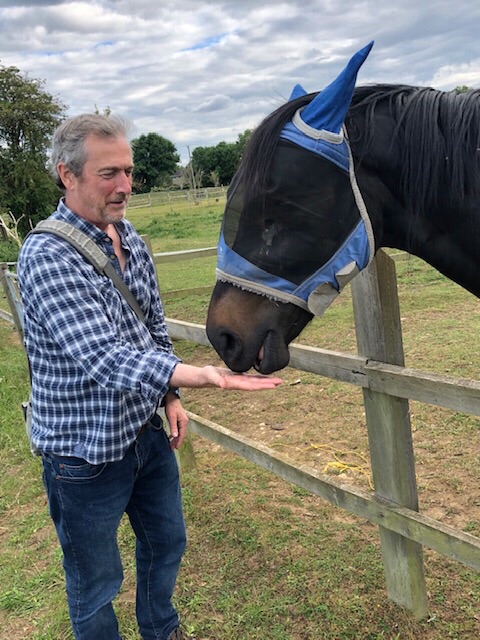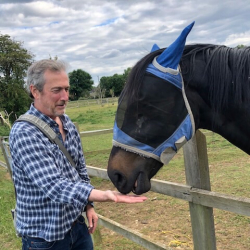Home > Topics > The Art of Photography > Landscape & Nature Photography > Magnolia
Magnolia
-
AuthorTopic: Magnolia Read 414 Times
-
Re: MagnoliaReply #1 on: May 30, 2021 at 9:53 am
A nice capture, but frankly, it doesn’t do the trick for me. I would have shot at a slower shutter speed and lower ISO to avoid the noise that’s fairly apparent in the background. However, that’s water over the dam. I think you could make much more of this by doing some postprocessing. I’d do a local noise reduction (excluding the flower because of the risk of loosing subtle detail there), remove some of the spots on the petals, crop to center the photo and to get rid of some background that doesn’t contribute, and then do some local adjustments–burning, dodging, and midtone contrast–to bring out details in the flower. I’ve done a fair number of white flowers, and they are very hard to do, as the detail is subtle.
I did a quick and dirty edit–not all the way there, but to start on each of those changes–but I didn’t post it because some people don’t like having others post edits of their photos, and I didn’t know whether you’d object.
Re: MagnoliaReply #2 on: May 30, 2021 at 1:40 pmYou’re welcome to post your modification, Daniel. It’s a snapshot of a flower. The only pictures I post-process to the extent you’re suggesting are street shots, which usually don’t need more than a brightness-range correction and sometimes a bit of sharpening.
I’m thinking about doing an essay on post-processing for my essay collection at http://www.russ-lewis.com/essays/index.html. Seems to me people get all wrapped around the axle on PP, trying to make everything “sharp” and noise-free. I always come back to HCB’s postulate: “Photographing is nothing. Looking is everything.” In other words, if you have something worthwhile in your photograph you don’t need to worry it to death. Just go with it. Were I making wall-sized prints I might worry more about PP, but I’m not — at least not any longer.
Re: MagnoliaReply #3 on: May 30, 2021 at 3:28 pm“Photographing is nothing. Looking is everything.” In other words, if you have something worthwhile in your photograph you don’t need to worry it to death. Just go with it. Were I making wall-sized prints I might worry more about PP, but I’m not — at least not any longer.”
This might make an interesting discussion in a thread of it’s own. IMHO, discounting processing in photography is kind of like telling a painter that she need only worry about finding an interesting view and need not worry about brushwork. If you haven’t seen it, you might find the video narrated by Ansel Adams son about Ansel’s editing of Moonrise Hernandez New Mexico interesting, https://www.shutterbug.com/content/watch-ansel-adams-son-discuss-how-his-father-made-his-most-famous-photo-video. It’s amazing how different the final version is from the original capture. Some examples by other photographers are here, https://retouchingacademy.com/history-of-retouching-photographers-and-retouchers-synergy-in-the-analog-photography-era/, along with a photo of the original and final Moonrise.
In any case, here is a very quick edit of your photo:
 Re: MagnoliaReply #4 on: May 31, 2021 at 11:29 am
Re: MagnoliaReply #4 on: May 31, 2021 at 11:29 amHi Daniel,
First of all: I see small but possibly important improvements in your revision – at least they might be important if you were planning a wall-sized print. On the other hand I see that you removed the small imperfections in the original that made it more believable, believability being photography’s forte.
I agree that the subject might make for an interesting discussion in a thread of its own, though I suspect we’ll have covered most of the available ground right here. As far as painters are concerned, if a painter is good he needn’t hunt for an “interesting view.” He can start with an interesting view in his head. It’s the difference that makes street photography the genre most important for photography. The result is – or was until Photoshop came along – believable to most people, even though Stalin demonstrated with his photographic removal of Trotsky that you can’t always believe your eyes.
Yes, I’m thoroughly familiar with the gyrations Ansel went through to produce the final version of Moonrise Hernandez. (Stalin’s folks could have learned a few things from him.) But I think the reason and the way he shot Moonrise is a lot more important than his later “corrections.” I wrote about it four years ago: http://www.russ-lewis.com/essays/WhyClicktheShutter.html.
I’ll close by quoting myself from http://www.russ-lewis.com/essays/WhatisPhotographyFor.html :
“Most people know who Ansel Adams was, and many of them have seen a few of his pictures – often in banks or doctors’ offices. But both Henri Cartier-Bresson and Robert Frank were far more influential photographers than Ansel was.”
That’s not to knock Ansel. Long ago I read everything Ansel wrote and took up the Zone System with a vengeance, at least when I was shooting with a stand camera. But Henri and Robert dealt with people, which is what strikes a note in the hearts of other people. That’s what a camera really is for. As far as I’m concerned, the best picture Ansel ever made was the picture of a woman behind a screen door.
Re: MagnoliaReply #5 on: May 31, 2021 at 4:14 pmHi Daniel,
First of all: I see small but possibly important improvements in your revision – at least they might be important if you were planning a wall-sized print. On the other hand I see that you removed the small imperfections in the original that made it more believable, believability being photography’s forte.
I agree that the subject might make for an interesting discussion in a thread of its own, though I suspect we’ll have covered most of the available ground right here. As far as painters are concerned, if a painter is good he needn’t hunt for an “interesting view.” He can start with an interesting view in his head. It’s the difference that makes street photography the genre most important for photography. The result is – or was until Photoshop came along – believable to most people, even though Stalin demonstrated with his photographic removal of Trotsky that you can’t always believe your eyes.
Yes, I’m thoroughly familiar with the gyrations Ansel went through to produce the final version of Moonrise Hernandez. (Stalin’s folks could have learned a few things from him.) But I think the reason and the way he shot Moonrise is a lot more important than his later “corrections.” I wrote about it four years ago: http://www.russ-lewis.com/essays/WhyClicktheShutter.html.
I’ll close by quoting myself from http://www.russ-lewis.com/essays/WhatisPhotographyFor.html :
“Most people know who Ansel Adams was, and many of them have seen a few of his pictures – often in banks or doctors’ offices. But both Henri Cartier-Bresson and Robert Frank were far more influential photographers than Ansel was.”
That’s not to knock Ansel. Long ago I read everything Ansel wrote and took up the Zone System with a vengeance, at least when I was shooting with a stand camera. But Henri and Robert dealt with people, which is what strikes a note in the hearts of other people. That’s what a camera really is for. As far as I’m concerned, the best picture Ansel ever made was the picture of a woman behind a screen door.
imperfections … more believable … I think this becoming more and more of an issue in photography. It strikes me as a search for authenticity and connection (other people, as you say) at a time when even PP is becoming automated. In turn that’s influencing what we expect from an image. One can see this in Adobe’s gradually more punchy and colourful defaults in Lightroom. Apple’s defaults saturate everything so far as I can tell and they must be clicked many millions of times a day. This approach is not to my taste but, as they say, if you see something often enough it can start to seem the normal thing.
More and more folks are switching to film to slow down, think and get away from it all. Good MF or 5×4 images on film can be superb. So I think this is very much a live issue, albeit with no one answer. Or if there is an answer it’s to blow the status quo out of the water to the point where nothing will be the same again which is what Frank did with The Americans. ‘PP’ is the last think I’d think of when looking at images that reach out and compel one’s attention. But I guess that only comes along a couple of times in a century. Maybe about time another one came along!
-
This reply was modified 3 years, 1 month ago by
 Mark Crean.
Mark Crean.
Re: MagnoliaReply #6 on: June 1, 2021 at 3:00 pmHi Mark,
Well said, my friend. I’d love to see another Robert Frank pop up and change the direction of photography, but I suspect we’re not going to see it. As I said in “What’s Photography For” (http://www.russ-lewis.com/essays/WhatisPhotographyFor.html):
I remember the reaction of the photographic community when that book [The Americans] came out. Popular Photography, which in those days actually dealt with photography rather than with equipment, panned the book. The problem was that The Americans dealt with us as we actually were in the fifties – showing “sanitation approved” motels and drugstore diners – rather than with the purified illusions presented by Norman Rockwell’s paintings and by photographers such as Alfred Eisenstadt who followed Rockwell’s lead. It was a giant flap, but Frank’s book became a classic and changed the whole course of street photography.
The problem, of course, is that we no longer have a comparable received image of ourselves that needs to be blown away by a depiction of reality.
I’ve done enough film work since 1953 in Korea when the war ended and I could go down town and shoot pictures of people, to understand that the medium isn’t the answer. You can do just as believable work with digital as long as what you’re after is the power of the relationships between people and between people and their environment rather than stuff that’s visually striking and pretty. There are a bunch of examples in my PXL street photography entries, but I keep coming back to the one I’ve attached, because the power of this one is wholly in the expressions of the principals. That’s often the case with street, and there’s really nothing you can do in Photoshop or Lightroom to change that.
-
This reply was modified 3 years, 1 month ago by
-
AuthorPosts
- You must be logged in to reply to this topic.




